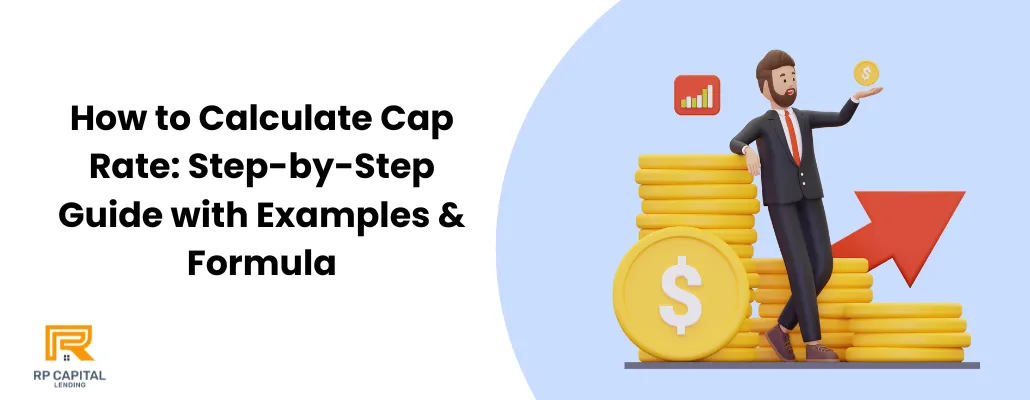Blog

How to Calculate Cap Rate: Step-by-Step Guide with Examples & Formula
The capitalization rate, or "cap rate," is one of the essential metrics for real estate investors. It's a quick measure to assess a property's profitability potential, helping investors make informed decisions about which properties are worth their investment. In this guide, we’ll cover what the cap rate is, how to calculate it using the cap rate formula, and provide examples to make the calculation process clear.
What Is Cap Rate?

Cap rate, short for capitalization rate, is a metric that real estate investors use to estimate the rate of return on an investment property. It reflects the potential profitability of a property by comparing its net operating income (NOI) to its purchase price or current market value.
Formula for Cap Rate:
Cap Rate=Property ValueNet Operating Income (NOI)×100
In simpler terms, the cap rate formula divides the income a property generates (after operating expenses) by its total value to express the return as a percentage.
Why Is Cap Rate Important?
Cap rate helps investors quickly understand the income potential of different properties and compare them against each other. For example, properties in high-demand, urban areas might have lower cap rates due to higher purchase prices, while properties in up-and-coming neighborhoods may have higher cap rates but come with additional risks.
How to Calculate Cap Rate: Step-by-Step Guide
Let’s break down the process of calculating cap rate step-by-step.
Step 1: Determine the Property’s Net Operating Income (NOI)
Net Operating Income (NOI) is the annual income a property generates after accounting for operating expenses but before mortgage payments or taxes. Here's how to calculate NOI:
Gross Rental Income: The total rent collected per year.
Operating Expenses: Expenses such as maintenance, insurance, property management fees, and utilities.
Net Operating Income (NOI): Subtract the total operating expenses from the gross rental income.
NOI=Gross Rental Income−Operating Expenses
Step 2: Find the Current Market Value or Purchase Price of the Property
To find the cap rate, you’ll need the current market value or purchase price of the property. This value can be based on a recent appraisal or the amount you paid if the purchase was recent.
Step 3: Apply the Cap Rate Formula
Use the formula to calculate the cap rate.
Cap Rate=Property ValueNOI×100
Example Calculation of Cap Rate
Imagine you have an investment property with:
Gross Rental Income: $100,000 per year
Operating Expenses: $30,000 per year
Property Value: $1,000,000
Calculate NOI: $100,000 - $30,000 = $70,000
Apply the Cap Rate Formula:
Cap Rate=1,000,00070,000×100=7%
In this example, the cap rate is 7%, meaning the property yields a 7% annual return on investment based on its income and value.
Visual Guide: Cap Rate Example Calculation
How to Interpret Cap Rates?
Cap rates vary based on property types, locations, and market conditions, but here’s a general guide:
Low Cap Rate (<6%): Often indicates a lower risk and stable investment, typically found in prime locations with high demand and consistent occupancy.
Moderate Cap Rate (6%-8%): Represents a balance between risk and return, ideal for medium-risk properties.
High Cap Rate (>8%): Indicates higher potential returns but may come with increased risks, often seen in emerging or less desirable markets.
Pros and Cons of Using Cap Rate
Advantages:
Quick and easy calculation
Useful for property comparison
Good initial indicator of investment potential
Disadvantages:
Doesn’t account for financing costs or tax implications
Can be inaccurate for properties with fluctuating incomes
Doesn’t factor in potential property appreciation
Factors That Influence Cap Rate
Location: High-demand areas typically have lower cap rates.
Property Type: Multifamily and office spaces often have different cap rates due to tenant variability.
Market Conditions: Economic changes affect demand and, therefore, cap rates.
Property Condition: Newer properties often have lower cap rates, reflecting lower maintenance costs.
Cap Rate vs. Other Investment Metrics
While the cap rate is useful, investors should also consider other metrics for a complete analysis, such as:
Cash on Cash Return: Focuses on actual cash flow after financing costs.
Internal Rate of Return (IRR): Considers cash flows over time, ideal for long-term investments.
Gross Rent Multiplier (GRM): Uses gross rental income, which can complement cap rate analysis.
Common Cap Rate Mistakes to Avoid
Using Inaccurate NOI Figures: Ensure all expenses are accounted for in NOI calculations.
Ignoring Market Trends: Cap rates vary with market conditions, so stay updated.
Overlooking Property-Specific Factors: Condition, occupancy rates, and other factors can heavily impact a property's true return.
Final Thoughts: Is Cap Rate Right for You?
Cap rate is a valuable tool, especially when used alongside other metrics, for analyzing property investment potential. By understanding cap rate, you can make more informed investment decisions and identify properties that align with your financial goals.
FAQs
1. What is a good cap rate for investment properties?
A "good" cap rate varies by market and property type. Generally, between 6%-8% is considered moderate, balancing risk and return.
2. How is cap rate different from ROI?
Cap rate measures potential return based on NOI and property value, while ROI considers the overall return on the total investment, including financing.
3. Can the cap rate change over time?
Yes, as property income or market value changes, the cap rate can fluctuate.
4. How do I calculate NOI accurately?
NOI is the annual gross rental income minus operating expenses, excluding financing costs and taxes.
5. Is a higher cap rate always better?
Not necessarily. Higher cap rates indicate higher returns but may also mean higher risk or lower property demand.
Also Read:
Understanding the Market Value of Land: A Comprehensive Guide for Property Investors
Disclaimer: Loans only apply to non-owner occupied properties. Rates, terms and conditions offered only to qualified borrowers, may vary upon loan product, deal structure, other applicable considerations, and are subject to change at any time without notice.
Copyright © 2025. All Rights Reserved.



